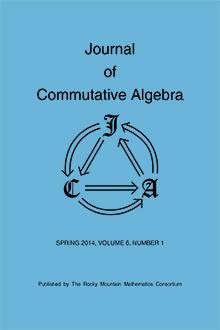Abstract
Let $S$ be a principal ideal domain. Recall that a Laurent polynomial algebra over $S$ is an $S$-algebra of the form $S[T_{1},\ldots, T_{n},T_{1}^{-1}, \ldots, T_{n}^{-1}]$. Generalizing this notion, we call an $S$-algebra of the form $S[T_{1},\dots, T_{n},f_{1}^{-1}, \ldots, f_{n}^{-1}]$ a quasi Laurent polynomial algebra in $n$ variables over $S$ if $T_{1},\ldots, T_{n}$ are algebraically independent over $S$ and $f_{i}=a_{i}T_{i}+b_{i}$, where $a_{i} \in S \backslash 0$ and $b_{i} \in S$ are such that $(a_{i}, b_{i})S=S$, for each $i=1, \ldots,n$. It has been shown recently that a locally Laurent polynomial algebra in $n$ variables over $S$ is itself a Laurent polynomial algebra. Now suppose $A$ is a locally quasi Laurent polynomial algebra in $n$ variables over $S$. In this note, we investigate the question: `is $A$ necessarily quasi Laurent polynomial in $n$ variables over $S$?' We first give a sufficient condition for the question to have an affirmative answer. Moreover, when $S$ is semi-local with two maximal ideals and contains the field of rationals $\mathbf{Q}$, we give examples of $S$-algebras which are locally quasi Laurent polynomial in two variables but not quasi Laurent polynomial in two variables.
Citation
A.M. Abhyankar. S.M. Bhatwadekar. "A note on quasi Laurent polynomial algebras in n variables." J. Commut. Algebra 6 (2) 127 - 147, SUMMER 2014. https://doi.org/10.1216/JCA-2014-6-2-127
Information





